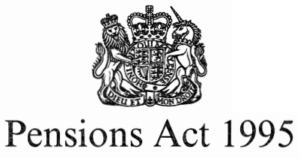Would you believe the Act is 25 years old this month, having come into force on 6 April 1997, and is probably the most important piece of legislation in the industry’s history? It was introduced to strengthen the pension schemes regulations following some unscrupulous behaviour of companies affecting their pension schemes in the early 1990’s, most notably Robert Maxwell stealing hundreds of millions of pounds from the Mirror Group’s pension schemes.
Having worked in the pensions industry for well over 30 years, I clearly remember when the Act received Royal Assent in 1995. There was panic in the industry over the amount of work needed to comply with all the new requirements. What followed was two years of hard work getting clients compliant.
So, what did the Act introduce and was it successful?
Well, there is no doubt that, overall, the Act was good for pension schemes. However, not everything introduced has been a success, let’s look back at the main features introduced and consider if they have been positive:
- The establishment of the Occupational Pensions Regulatory Authority (OPRA) to oversee the running of pension schemes
Introducing a body responsible for overseeing the appropriate running of pension schemes is obviously positive. However, OPRA’s powers weren’t particularly strong and a new body, the Pensions Regulator (tPR), was created under the Pensions Act 2004 replacing OPRA from 6 April 2005. The Pensions Regulator has much wider powers than OPRA and takes a proactive approach so is much better equipped to oversee the pension industry. Those who have had the “pleasure” of locking horns with tPR are fully aware of the pain it can inflict if it has concerns at the way your pension scheme is being run. - The introduction of a Minimum Funding Requirement (MFR) to ensure all pension schemes had a minimum amount of money to provide members’ benefits
Although this sounds great in theory the practice was rather different. The MFR level was set low and the carve out of assets on a company’s insolvency was biased towards pensioners, which meant people yet to retire lost out significantly. As an example, in the well-known Allied Steel and Wire case, following the collapse of the company in 2002, non-pensioners received only a small proportion of their entitlements. This meant a re-think on the level of protection for pensions and resulted in the introduction of, firstly, the Financial Assistance Scheme (FAS) and then, in 2006, the Pensions Protection Fund (PPF). Both FAS and the PPF provide a higher level of protection than the MFR, but still fall short of providing 100% protection. - Requiring schemes to provide a minimum guaranteed level of pension increase
Prior to 1997 there was no need to provide increases on pensions in retirement (apart from a small element of Guaranteed Minimum Pension, but that’s an article in itself!). This means that members’ earning power of their pension diminishes over time, quite easily halving in value whilst they are retired. The Act introduced a requirement for all pensions earned after 5 April 1997 to be increased when in payment by the lesser of inflation and 5% each year. This is a great benefit to pensioners. - Introducing a compensation fund for pension schemes in the event of fraud and protecting existing pension benefits so that they could not be reduced in the future without member consent
Anything that protects members’ benefits from being reduced has got to be positive and these two features have further enhanced the protections for members. - The requirement for member nominated trustees
Trustee boards were previously full of company directors and shareholders which meant that decisions made often had a bias towards the company. Requiring members to have representation on Trustee boards was a positive step as they are able to put the members’ point of view across in the decision process. Such trustees are also able to review member communications from the members’ perspective to ensure they will be understood and are often a “friendly” point of contact for members with questions. - Other features
There were other aspects introduced which have also helped frame the pension rules under which we currently work, such as:- Greater disclosure of information for members.
- The requirement to have in place a Statement of Investment Principles.
- A formal dispute resolution procedure, if members have a dispute with their pension scheme.
- The requirement to formally appoint a Scheme Actuary and Scheme Auditor.
Summary
As you can see, the Act introduced a large number of wide-ranging changes to the way pension schemes are governed. Some of these changes have withstood the test of time, but have been updated and improved over the years or deemed inappropriate and replaced with a better alternative.
Having worked in pensions for the whole of this period, there is no doubt the Act, and its many subsequent changes, have been successful in setting a strong legislative framework for UK pensions. However, it doesn’t end there and a new Act, the Pension Schemes Act 2021, is introducing yet more changes. Thankfully I am retiring at the end of April and therefore won’t need to learn about all these new changes. Thirty plus years of change is enough for me!
Mark Vincent
Quantum Advisory
April 2022

